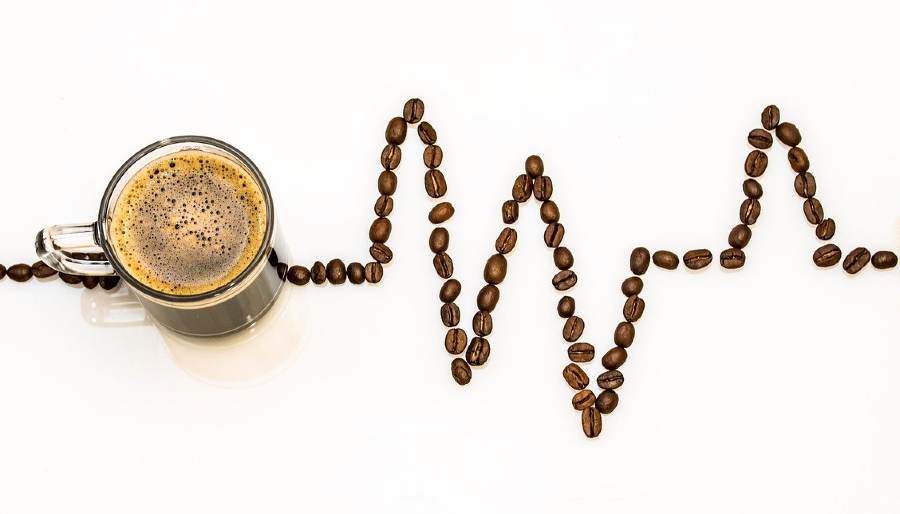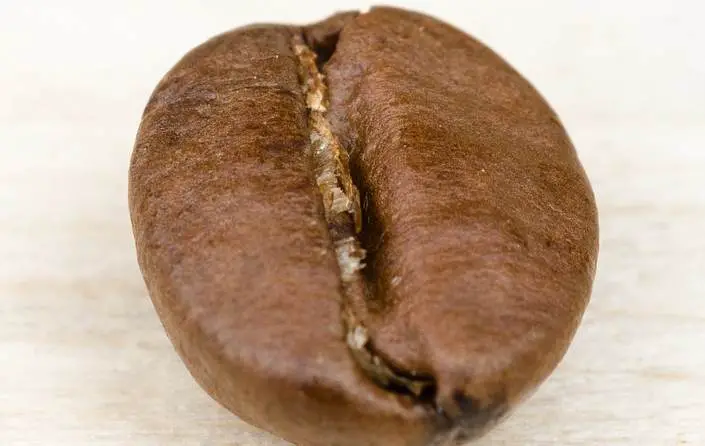
Caffeine occurs naturally in the coffee plant and coffee cherries have a higher caffeine concentration than the other parts of the plant. All three parts (bean, the skin, and the pulp) of a coffee cherry contain caffeine.
According to PubMed Central, up to 40 percent of the caffeine in a coffee cherry is lost in de-pulping during wet processing. Fortunately, coffee beans pack more caffeine than coffee pulp.
How much caffeine is in coffee beans?
On average, a single Arabica coffee bean has about 1.6 milligrams of caffeine whereas a Robusta coffee bean contains about 2.9 milligrams of caffeine. Caffeine constitutes about 1.2% and 2.2% of the total bean weight for Arabica and Robusta coffee respectively. There is minimal change in caffeine content during roasting.

The average weight of a single roasted coffee bean is about 132mg and caffeine accounts for 1.2% and 2.2% of the total weight in arabica and robusta coffee respectively. Inevitably, not all the caffeine in the coffee beans is extracted during brewing.
The amount of caffeine that ends up in your cup depends on factors such as the brewing method, grind size, and water temperature.
The amount of caffeine in coffee varies depending on factors such as the type of coffee beans, the type of soil, and the geographical area where the coffee is grown as well as the environmental conditions.
Generally, coffee that is grown in higher altitudes has lesser caffeine than lower altitude coffee hence the reason Arabica has lesser caffeine than Robusta. The higher caffeine level in Robusta shields the coffee from pests and diseases in harsh growing conditions.
Caffeine Content in Green Coffee Beans vs Roasted Coffee Beans
Roasted coffee beans have more caffeine content per gram as compared to before roasting because the beans undergo chemical processes that interfere with the density and moisture content during roasting. Roasted coffee beans are lighter than green beans whereas the total caffeine content remains largely unchanged.
In the past, it was believed that coffee beans lose significant amounts of caffeine as you roast towards darker roasts but this myth has since been debunked.
Ground coffee has the same amount of caffeine as whole coffee beans because grinding does not impact the caffeine content.
How Much Caffeine in 10 Grams of Coffee Beans?
10 grams of roasted coffee beans have about 120 milligrams of caffeine for arabica coffee as caffeine constitutes 1.2% of the weight of the coffee. On the other hand, 10 grams of robusta coffee beans have about 220mg of caffeine (2.2% of the total weight).
However, the actual amount of caffeine in your coffee beans can be significantly higher or lower than these averages and you are better off checking the actual amount of caffeine with your beans supplier or roaster.
To help you further understand the amount of caffeine in coffee, see this post about the caffeine content in a tablespoon of ground coffee.
Which Coffee Has Less Caffeine?
Decaf coffee has the least amount of caffeine and contains at least 97% less caffeine than regular coffee. An 8oz mug of decaf has about 7mg of caffeine whereas an 8oz cup of regular coffee can have as high as 140mg of caffeine.
See how the caffeine in coffee relates to how long you store the coffee.
Is 200mg Caffeine a Lot?
For a healthy individual, 200mg of caffeine is within the FDA-recommended daily caffeine intake of not more than 400mg. So 200mg caffeine may not affect a healthy individual.
For kids, adolescents, and people with caffeine intolerance issues, 200mg of caffeine is a lot.
Health Canada advises 2.5mg of caffeine per kilo of body weight for teenagers who are at least 13 years old and 85mg of caffeine for 10 to 12-year-old kids per day.
Women who are planning to get pregnant, pregnant women, and breastfeeding mothers can safely consume up to 300mg of caffeine per day according to Health Canada.
Do You Get Caffeine From Eating Coffee Beans?
Yes, you can get caffeine from eating coffee beans. Your body absorbs caffeine much faster when you eat coffee beans than it absorbs from liquid coffee, according to Healthline.
There is no telling the actual percentage of caffeine that your body extracts from the coffee beans when you eat them. A single coffee bean delivers about 1.6mg when you eat it.
Chocolate-coated coffee beans have a much higher caffeine content as the chocolate coating also contains caffeine. Some chocolate-covered coffee beans contain as high as 12mg of caffeine and an average of 7mg of caffeine per bean, which is more than triple the amount of caffeine in a bean of arabica coffee.
Eating coffee cherries delivers a much higher caffeine content given that the pulp contains nearly the same amount of caffeine as the coffee bean. However, green beans are very dense and can crack your tooth. Red arabica coffee cherries are sweet due to the red pulp but the bean is grassy.
Why Does Coffee Have Caffeine?
Studies have shown that the coffee plant uses caffeine to:
1. Attract Insects During Pollination
A study involving honey bees and nectar from coffee found that the nectar contains small amounts of caffeine that stimulate the memory of the bees so that the bees keep coming back to the coffee trees for more nectar thus boosting pollination.
The amount of caffeine in the coffee flowers is just enough to pharmacologically influence the behavior of pollinators without harming them.
2. Defend Against Pests
Plants produce caffeine as a pesticide. Coffee plants have caffeine in the leaves and cherries to ward off pests. High amounts of caffeine are toxic and sometimes lethal for smaller-bodied insects.
However, some of the insects have gone A-game mode by evolving their receptors to detect and avoid ingesting caffeine.
3. Poison Competing Plants
Coffee leaves and cherries that drop on the ground add caffeine to the soil to inhibit the germination and growth of competing plants. The branches also block direct light from reaching the undergrowth hence eliminating competition.
Recap
The amount of caffeine in coffee beans remains the same even as the beans are roasted and then ground to make coffee. When brewing coffee, not all of the caffeine is extracted and used grounds still have some caffeine.
Eating coffee beans provides caffeine that the body absorbs faster than when your drink coffee.
Related Questions
Does Boiling Coffee Remove Caffeine?
No, you do not remove caffeine when you boil coffee. The coffee just boils but the caffeine remains intact. Boiling your coffee is not recommended because it leads to the loss of some of the flavors and the coffee becomes more bitter.
Similarly, using boiling water to brew your coffee is undesirable because you over-extract the soluble compounds in the coffee including caffeine and the bitter flavors leading to a drink that is too strong and very bitter. The optimal water temperature to brew your coffee is just below boiling point (195-205°F).
